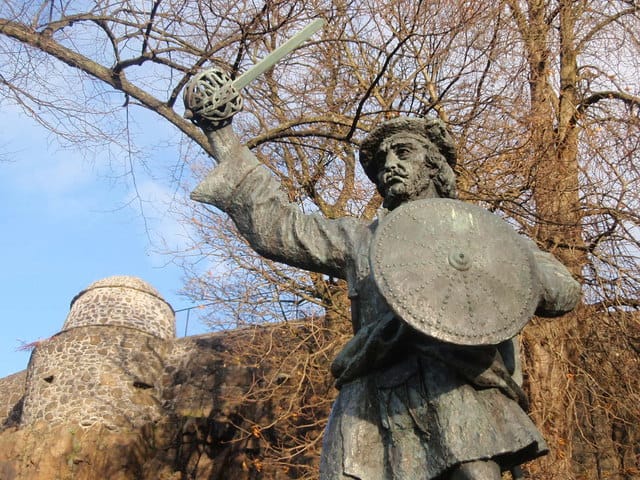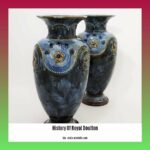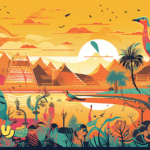Get ready to explore the captivating history of the MacGregor Clan, a Scottish family whose story reads like an epic adventure. From their alleged royal origins to their dramatic fall from grace and their eventual return, the MacGregors have left an enduring mark on Scottish history. This captivating clan has faced banishment, betrayal, and brutal conflict, yet their spirit has never been broken. Join us as we delve into their tumultuous past, uncover their unique culture, and witness their remarkable resilience.
History of the MacGregor Clan
The MacGregor clan’s history is a tapestry woven from threads of royal connections, ancient customs, and an unyielding spirit. Their story is believed to begin with Griogair, a figure shrouded in the mists of time who was said to be a descendant of King Alpin of Scotland. This claim, whether rooted in historical fact or embellished through generations of storytelling, is proudly proclaimed in their clan motto, “Royal is my race.”
The MacGregors, always a proud and independent clan, embraced symbols that reflected their heritage. Their clan crest, featuring a lion’s head adorned with a crown, serves as a powerful reminder of their alleged royal bloodline. Beyond symbols, they were also pioneers in the realm of music, embracing the haunting melodies of the bagpipes as early as the 1600s, long before they became an iconic symbol of Scotland itself.
However, their story, like many throughout Scottish history, is not without its share of drama and conflict. The MacGregors often found themselves at odds with other powerful clans, most notably the Campbells. This bitter rivalry would eventually lead to their downfall when King James VI, influenced by the Campbells and angered by the MacGregors’ perceived defiance of his authority, declared them outlaws in 1603.
Forced into hiding, stripped of their lands and their very name, the MacGregors earned the moniker “Children of the Mist.” This period of persecution, known as the “Proscription,” tested their resilience like never before. Yet, even in the face of such adversity, they never surrendered their identity. Many continued to use their forbidden name in secret, clinging to their heritage as a badge of honor.
The MacGregors’ story is not simply one of tragedy and oppression. They played a significant role in the Jacobite risings, demonstrating their unwavering courage and determination on the battlefield. Their unwavering loyalty to their cause cemented their place in the annals of Scottish history, proving that even as outlaws, they were a force to be reckoned with.
Today, the legacy of the MacGregor clan extends far beyond the battlefields of the past. Their influence can be felt in the haunting melodies of traditional Scottish music, the captivating tales passed down through generations, and the rich tapestry of Scottish folklore. They may not have always had it easy, but the MacGregors’ spirit continues to inspire, a testament to the enduring power of kinship, resilience, and cultural identity. Their story, far from being a relic of the past, reminds us that even in the face of immense hardship, the human spirit can endure, adapt, and ultimately, triumph.
Why was Clan MacGregor banned?
To understand why the MacGregor clan faced such a harsh fate, we need to step back in time to a Scotland where clan rivalry was a fact of life, and power struggles could turn deadly. The MacGregors, known for their fierce independence and sometimes ruthless tactics, had a long and bloody history with other clans, particularly the powerful Campbells.
The event that ultimately led to their downfall was the Battle of Glen Fruin in 1603. This wasn’t just a skirmish; it was a full-blown clan war against their rivals, the Colquhouns, resulting in the deaths of over 140 men. While the MacGregors emerged victorious, their triumph came at a steep price.
King James VI, eager to consolidate his power and establish order in the Highlands, saw the massacre as a direct challenge to his authority. The Campbells, wielding considerable influence at court and eager to exploit the situation to their advantage, seized the opportunity to deliver a crushing blow to their rivals.
Under intense pressure from the Campbells and facing what he perceived as an act of open rebellion, King James VI took the drastic step of outlawing the entire MacGregor clan. In 1603, he declared their very name illegal, stripped them of their lands, and forced them into hiding. Imagine the fear and uncertainty of having to abandon your home, your identity, and your way of life – that was the reality facing the MacGregors.
Some historians suggest that the MacGregors’ reputation as a “wild” and uncontrollable clan played a role in their downfall. They were often perceived as a threat to the established order, with their fierce independence and history of violence making them a target for those seeking to consolidate power in the Highlands.
The ban on the MacGregor name was more than just a symbolic act; it had devastating consequences for the clan. It meant living in constant fear of persecution, forced to assume new identities, and denied the basic rights afforded to other clans. Yet, even in the face of such adversity, the spirit of the MacGregors remained unbroken. They clung to their traditions in secret, passing down their stories and their pride to future generations. The outlaw years, though fraught with hardship, would ultimately forge an even stronger sense of identity and kinship among those who bore the MacGregor name, even in secret.
What is the story behind the MacGregor Clan?
The story of the MacGregor clan is a captivating blend of historical fact, enduring legends, and a stubborn refusal to be erased from the pages of Scottish history. Their claims of ancient lineage, their struggles against powerful enemies, and their ability to survive centuries of persecution make them one of the most intriguing clans in Scottish history.
Whispers of Royal Blood
The MacGregors have always maintained, with unwavering conviction, that their lineage can be traced back to King Alpin MacAlpin, the first king to rule over a unified Scotland. This claim, passed down through generations, is more than just a point of pride; it forms a cornerstone of their clan identity. While definitive historical evidence remains elusive, the possibility of royal blood adds another layer of intrigue to their already captivating story.
Children of the Mist: A Time of Shadows
Imagine being hunted simply for bearing your family name. This was the harsh reality for the MacGregors during the 17th and 18th centuries. The Proscription, enacted in 1603, cast them as outlaws, depriving them of their lands, their rights, and their very identity. Forced to live in the shadows, they sought refuge in the remote and rugged Highlands of Scotland. It was here, amidst the towering peaks and misty glens, that they earned the name “Children of the Mist,” using their knowledge of the land to evade their enemies and preserve their way of life. This period of persecution tested their strength and resolve, forcing them to rely on their wits, their courage, and their unwavering loyalty to one another to survive.
The Campbell Conflict: A Feud For the Ages
Clan rivalries were a fact of life in the Highlands, but the feud between the MacGregors and the Campbells was particularly bitter and enduring. This clash of titans stemmed from a complex web of territorial disputes, political aspirations, and a longstanding animosity that had simmered for generations. The conflict came to a head at the Battle of Glen Fruin in 1603, where the MacGregors, outnumbered but determined, inflicted a crushing defeat on their Campbell rivals. However, this victory proved to be a pyrrhic one, as the Campbells, with their influence over the Crown, used the battle as a pretext to outlaw the MacGregor clan and seize their lands.
The Legend of Rob Roy: A Symbol of Defiance
The story of the MacGregor clan would not be complete without mentioning one of their most iconic figures, Rob Roy MacGregor. Born in 1671, Rob Roy was more than just an outlaw; he was a skilled swordsman, a cunning cattle rustler, and a Robin Hood-esque figure who fought against injustice and defended his people. His exploits, immortalized in literature and celebrated in folklore, made him a symbol of resistance against oppression and a potent reminder that the MacGregor spirit could not be extinguished, even by the most powerful of enemies.
Emerging from the Mist: A Legacy Renewed
The darkness of the Proscription eventually began to lift in the 18th century. After over 150 years of persecution, the MacGregor clan was finally granted a measure of freedom. The lifting of the ban on their name in 1774 allowed them to begin the long and arduous process of rebuilding their lives and reclaiming their place in Scottish society. While the scars of the past remained, the MacGregors had proven their resilience and emerged from the shadows with a renewed sense of purpose. They had faced their darkest hour and emerged, not as victims, but as survivors.
Today, the MacGregor clan thrives, their story a testament to the enduring power of kinship, resilience, and cultural identity. Organizations like the MacGregor Society work tirelessly to preserve their traditions, document their history, and ensure that the sacrifices of their ancestors are never forgotten. The Children of the Mist, once forced into hiding, now stand tall, their story an inspiration to anyone who has ever faced adversity and refused to be defined by their past.
Who is the most famous MacGregor?
When someone mentions the name “MacGregor” in the 21st century, one figure likely comes to mind before any other: Conor McGregor. This Irish-born mixed martial artist has skyrocketed to global fame, becoming one of the most recognized and polarizing figures in the world of combat sports.
Born in Dublin in 1988, Conor’s journey to becoming a UFC champion is the stuff of legend. He burst onto the professional MMA scene in 2013, captivating audiences with his aggressive fighting style, his unwavering self-belief, and his knack for self-promotion. He wasn’t just winning fights; he was finishing opponents in spectacular fashion, backing up his bold predictions with devastating power and precision.
In 2015, the world watched as he faced off against Jose Aldo, the reigning UFC Featherweight Champion and a legend in his own right. What followed was one of the most iconic moments in UFC history. With a single left hook just 13 seconds into the first round, Conor knocked Aldo out cold, becoming the undisputed Featherweight Champion and solidifying his place as a global superstar.
But Conor’s ambition didn’t end there. He set his sights on conquering another weight class, moving up to lightweight and claiming the UFC Lightweight Championship in 2016. This victory made him the first fighter in UFC history to hold titles in two different weight divisions simultaneously, a feat that cemented his legacy as one of the greatest mixed martial artists of all time.
Conor’s fame extends far beyond the octagon. He has graced the covers of countless magazines, appeared on major talk shows, landed lucrative endorsement deals, and even found himself included in Time magazine’s list of the 100 most influential people in the world.
While there have been other notable figures throughout history bearing the MacGregor name, Conor’s achievements in the world of combat sports, combined with his larger-than-life personality and global brand recognition, make him arguably the most famous person to carry the MacGregor name in the 21st century.
To learn more about Conor McGregor’s journey and his impact on the world of MMA:
- Conor McGregor’s Wikipedia Page: An excellent starting point for exploring his career highlights and personal life.
- YouTube Search: A treasure trove of fight highlights, interviews, and documentaries showcasing Conor’s rise to fame.
- Articles and Interviews: Dive deeper into Conor’s impact on MMA, his business ventures, and his influence on popular culture.
What surnames did the MacGregors take?
Imagine being stripped of your name, your identity, and your heritage. That was the harsh reality for the MacGregor clan after they were outlawed by King James VI in 1603. To survive, they had to become masters of disguise, adopting new surnames to avoid persecution.
Some of the most common surnames adopted by the MacGregors include:
- Murray
- Graham
- Stewart
- Grant
- Campbell (ironically, the clan they feuded with most intensely)
It’s a testament to their resourcefulness and determination that they found ways to blend in, often taking on names that were common in the regions where they sought refuge. It was a matter of survival, but it also highlights the importance of family and kinship. Even though they couldn’t openly use their name, they kept their traditions and stories alive, passing them down through generations, ensuring that their true identity would never be forgotten.
The lifting of the ban in 1774 marked a turning point for the MacGregors. They were finally free to reclaim their name and their heritage. But the years of hiding had left their mark. To this day, you’ll find MacGregors around the world who still bear these assumed names, a poignant reminder of their ancestors’ struggle for survival.
What does MacGregor mean in Scottish?
The name MacGregor is deeply rooted in Scottish Gaelic, a language that reflects the rich history and cultural heritage of Scotland. In its simplest form, MacGregor means “son of Griogar.” This patronymic surname structure, common in Scotland and Ireland, directly links individuals to their fathers and their clans, creating a strong sense of lineage and belonging.
“Griogar” itself is the Gaelic form of the given name “Gregory,” a name with Latin origins meaning “watchful” or “vigilant.” So, when you meet someone named MacGregor, you’re essentially encountering a descendant of someone named Gregory, way back in time.
The Gaelic form of MacGregor, “MacGriogair,” further emphasizes the clan’s connection to their Gaelic roots. Despite centuries of cultural and linguistic shifts, the name has retained its core meaning, a testament to the enduring power of language and tradition.
The name MacGregor, though seemingly straightforward, carries the weight of a complex and often turbulent history. It speaks to the clan’s claimed royal lineage, their struggles for survival, and their enduring legacy in Scottish culture. It’s a name that evokes images of misty Highlands, fierce warriors, and an unyielding spirit that refused to be extinguished.
Is MacGregor royalty?
The MacGregors have long claimed a direct lineage to King Alpin, the first king of a unified Scotland. Their motto, “Royal is our race,” reflects this belief, a source of pride that has been passed down through generations. However, concrete historical evidence to support their claim remains elusive.
While their connection to King Alpin is difficult to prove definitively, the possibility is intriguing. The mists of time often obscure the full picture of ancient lineages, leaving room for speculation and debate. Even without a documented bloodline, the MacGregors’ unwavering belief in their royal ancestry has undoubtedly shaped their clan identity and fueled their sense of pride.
Adding another layer of complexity to their story is the MacGregors’ tumultuous relationship with the Scottish crown. Their fierce independence and resistance to authority often put them at odds with those in power. The brutal clan feuds, particularly their conflict with the Campbells, further complicated matters, culminating in their outlaw status in the 17th century.
Despite the lack of official recognition, the MacGregors have clung to their belief in their royal heritage. It’s a testament to the power of oral history, clan legends, and the enduring strength of cultural identity. Whether or not they sit on a throne, their impact on Scottish history and their legacy as a resilient and proud clan remain undisputed.
Who can wear MacGregor tartan?
Traditionally, tartan was more than just a fabric; it was a powerful symbol of clan identity and belonging in the Scottish Highlands. Each clan had its own unique tartan pattern, often passed down through generations and worn with immense pride.
If you have a MacGregor ancestor, you’re welcome to wear their clan tartan. It doesn’t matter if the connection is on your mother’s or father’s side, or how far back you have to trace your family tree. That ancestral link is your ticket to proudly displaying the MacGregor colors.
The MacGregor clan actually has four recognized tartans:
- Red & Black: This striking tartan, with its bold contrast, is a popular choice for those seeking a classic look.
- Red & Green: The most widely recognized MacGregor tartan today, it rose to prominence during King George IV’s visit to Edinburgh in 1822.
- Glengyle: This tartan, named after a region historically associated with the clan, offers a more understated and earthy color palette.
- Cardney: With its vibrant mix of colors, the Cardney tartan is a less common but equally striking choice.
Exploring Your Family History:
If you’re unsure about your clan connections but interested in learning more, there’s never been a better time to delve into your family history. Numerous online resources and organizations are dedicated to helping people trace their ancestry, and you might be surprised at the fascinating stories you uncover.
Important Note:
While these guidelines are generally accepted, the world of tartans and clan affiliation can be complex, with ongoing discussions about historical accuracy and cultural sensitivity. If you’d like to delve deeper into the intricacies of tartan etiquette or have questions about specific clan connections, reaching out to a Scottish heritage organization or clan society can provide valuable insights.
Is Clan MacGregor Scotch good?
Clan MacGregor, a blended Scotch whisky, is like the approachable friend in a world of complex characters. It’s a blend of 15 different whiskies sourced from various regions of Scotland – the Highlands, Lowlands, and the renowned Speyside – resulting in a surprisingly smooth and well-rounded flavor profile.
One of the key appeals of Clan MacGregor is its affordability. It’s not a single malt designed to impress connoisseurs; it’s an everyday Scotch made for enjoyment without breaking the bank. And on that front, it delivers admirably.
Upon sipping Clan MacGregor, you’ll likely notice a pleasant graininess, a touch of honeyed sweetness, and subtle hints of biscuit or shortbread. It’s not overly complex, but it’s well-balanced and easy to drink, making it a great choice for those new to Scotch or whisky in general. The finish is relatively short but pleasant, with that lingering sweetness fading gently.
Is Clan MacGregor going to blow your mind with layers of peat smoke, sherry notes, or complex spice? Probably not. But that’s not its goal. It aims to provide a solid and enjoyable Scotch experience at a price that won’t make you wince, and on that front, it succeeds.
If you’re looking for an affordable introduction to the world of blended Scotch, a reliable bottle for casual sipping, or a mixer that won’t overpower your cocktails, Clan MacGregor is definitely worth a try. You might be pleasantly surprised by how much you enjoy this unpretentious and easy-drinking whisky.
What’s the difference between McGregor and MacGregor?
At first glance, “McGregor” and “MacGregor” might seem like interchangeable spellings of the same name. However, in the context of this article, these two variations represent distinct entities with their own unique stories.
McGregor (Clan): When capitalized, “McGregor” generally refers to the historical Scottish clan. We’re talking kilts, bagpipes, ancient feuds — the whole nine yards. This clan hails from the Perthshire region of Scotland, and their history dates back to the 13th century. They even have their own coat of arms, featuring a fierce red lion.
MacGregor (Various Entities): The lowercase “MacGregor” is most commonly associated with MacGregor Yachts, a California-based sailboat manufacturer established in 1973 by Robert MacGregor. Known for their innovative designs, particularly their water-ballasted sailboats, MacGregor Yachts has made a name for itself in the boating world.
So, while the name might look familiar, context is key. It’s like having two friends named John Smith – you need more information to know which John you’re talking about.
To summarize:
| Name Variant | Meaning | Origin |
|---|---|---|
| McGregor (clan) | A Scottish clan with a long and fascinating history, often associated with figures like Rob Roy MacGregor | Perthshire, Scotland |
| MacGregor (yachts) | A company known for innovative sailboat designs, particularly those with water-ballast systems | California, USA |
Why did Scottish clans fight each other?
The Scottish Highlands, often romanticized for their rugged beauty and fierce independence, were also a stage for centuries of inter-clan conflict. These weren’t just isolated skirmishes, but often protracted and brutal feuds that shaped the social, political, and geographical landscape of Scotland. To understand why these clans fought, we need to look beyond the romanticized image of kilts and bagpipes and delve into the complex realities of life in the Highlands.
Land, Resources, and Survival:
At its core, much of the conflict stemmed from the same basic needs that have driven human conflict for millennia: land, resources, and survival. In the unforgiving terrain of the Highlands, land wasn’t just about prestige or power; it represented survival itself. More land meant more access to fertile grazing for livestock, more opportunities for agriculture, and ultimately, a greater chance of prosperity for the clan. As clans grew in size and ambition, competition for these limited resources inevitably led to friction and often, outright war.
Power, Prestige, and Political Ambition:
Beyond the basic necessities, clan chiefs, the leaders tasked with guiding and protecting their people, often harbored political ambitions. Influence and power were fluid concepts in the Highlands, and a shrewd chief could leverage strategic alliances, marriages, and military victories to expand their clan’s territory and influence. This constant jockeying for position created a volatile environment where even a minor dispute could quickly escalate into a full-blown conflict, fueled by generations of rivalry and a desire for dominance.
Feuds: When Grudges Became Legacy:
One of the most fascinating and tragic aspects of clan warfare was the concept of the “feud.” These weren’t simply isolated disagreements; they were deep-seated, often centuries-old vendettas passed down through generations like a poisoned chalice. Imagine a grudge so profound that it outlived the individuals involved, fueling cycles of violence and revenge that could span centuries. Feuds often stemmed from perceived insults to honor, acts of treachery, or the desire to avenge past wrongs. They were a brutal reminder of the enduring power of resentment and the human capacity for holding onto grievances long after their initial spark had faded.
The Legacy of Clan Warfare:
While large-scale clan warfare is thankfully a relic of the past, its impact on Scottish history and culture is undeniable. It shaped the boundaries of clan territories, influenced the development of Scottish law and social structures, and left behind a legacy of both pride and sorrow. The stories of these conflicts, passed down through generations, continue to captivate us, reminding us of the complexities of human nature and the enduring power of kinship, loyalty, and the often-brutal struggle for survival.
Further Exploration:
For those interested in delving deeper into the fascinating and often brutal world of clan warfare, “Highland Clan Warfare in the Sixteenth and Seventeenth Centuries: The Jacobite Highlands” by E.J. Cowan is an excellent starting point. This comprehensive work explores the intricacies of clan rivalries, the tactics employed in warfare, and the lasting impact these conflicts had on Scottish society.
- Star Ring Trends: Etsy vs Amazon - March 28, 2025
- Boost Pollinator Habitats: Baby Blue Eyes Sustainable Farming Guide - March 28, 2025
- Protect Big Black Bears: Effective Conservation Strategies - March 28, 2025
















